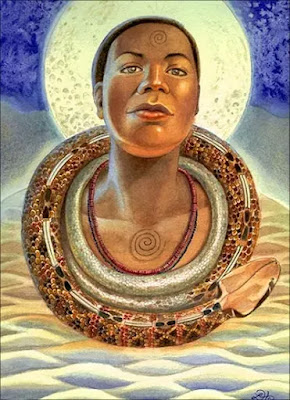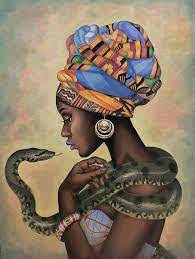Goddess Minona
Minona: West African goddess of protection.
The Fon people refer to Minona as the woman's guardian.
She bestows fertility to women and guards them from
conception until death.
She can predict the future and teaches shamans how to
utilize palm kernels for divination.
Goddess Mbaba Mwana Waresa
Mbaba Mwana Waresa: African Rainbow Goddess.
Mbaba Mwana Waresa, the Zulu goddess of beer, is revered by the Zulu people of South Africa.
She has control over the elements of water and soil, hence
she oversees agriculture and harvests.
Mbaba Mwana Waresa, also known as Lady Rainbow, is the
connection between the gods and humans, the realm-crossing bridge.
Thandiwe, a mortal, is her partner, and he has done
countless legendary deeds at her behest to show his worthiness to her.
Goddess Mawu
Mawu is a West African deity of the moon.
Mawu is the goddess of the moon and the night sky, and the Fon people revere her for the chilly temperatures she gives.
She is the epitome of motherhood, teaching her people to
honor and cherish their elders' knowledge.
The sun god Liza is her twin and consort, and the two of
them produced the seven pairs of twin deities that impact the planet.
Mawu worships cowrie jewelry.
Goddess Mami Wata
Mami Wata: African water goddess
Mami Wata is a water goddess who appears in dreams and hallucinations to her devotees.
She bestows money and health on those who ask for it, and
she has a reputation for cursing the wicked with disease.
Petitioners give her perfume and pleasant liquids in
exchange for her signature.
She takes on the form of a mermaid or a lovely lady clothed
in red and white.
Goddess Inkosazana
Inkosazana is a goddess of
agriculture in Africa.
Inkosazana is known as "Lady Heaven" by the Zulu
people because she governs the heavenly bodies and the lives of women.
She is the driving force behind the growth of maize and
other crops.
Rainbows and rain are often connected with her.
Goddess Enekpe
Family goddess in Africa.
Enekpe, especially within the family blood line, is the Guardian of Destiny.
Her devotees allegedly went to battle and were on the verge
of extinction.
In order to rescue her people, Enekpe gave herself as a
sacrifice.
Her tribe was rescued, their linage sanctified for forever
by her blood, and she was buried alive on the battlefield.
Goddess Erzulie
Goddess of love from West Africa.
Erzulie, a goddess of Africa, is currently mostly venerated in the Afro-Carribean Voudun tribes.
She is a goddess of beauty, wealth, and the arts,
particularly dancing.
She is feared and adored for her immense strength, as well
as her erratic mood swings.
Followers of Erzulie believe that once you are in her good
graces, you will never be in need again; but, if you offend her, your remaining
days will be spent in her anger.
Prostitutes and any sexual activity are patronized by
Erzulie.
She is usually summoned via ceremonial dancing or ritual baths with pricey oils and fragrances.
Goddess Aziri
- Aziri is the goddess of riches and possessions who guards markets and commercial dealings.
- In order to preserve balance and prevent patriarchal rule and authority, she distributes her financial gifts and opportunities disproportionately to women.
- She is also revered as a goddess of love, guarding women against unsuitable partners and males seeking financial gain via marriage.
- Thieves and con artists, especially those who exploit women, face Aziri's wrath.
Goddess Asase Yaa
Asase Yaa is Africa's harvest goddess.
- Asase Yaa is known as "Old Woman Earth" by the Ashanti people of West Africa.
- Farmers call on her to bless their harvests in the fields.
- She is the ultimate harvest, assisting her children in reaping the benefits of the seeds they have sown throughout their lives.
- Asase Yaa is revered as humanity's mother, providing life for her offspring and reuniting them with them after death.
- She is the back bending, the sweat, the toil, and the final nourishing reward.
- Thursday is a holy day for her.
Goddess Aja
Aja is a West African woodland goddess.
- Her disciples learn herb knowledge from her, guaranteeing their bodily and spiritual well-being.
When supernatural entities accept or reject ceremonial offerings, Osun and the Aje play a significant role.
Legends, Belief And Folklore Associated with Goddess Aja.
Aja is an Orisha in Yoruba mythology, patron of the forest, its animals, and herbal healers, whom she taught their craft.
- Aja may also refer to a "wild wind" in Yoruba.
- If someone gets taken away by aja and later returns, it is said that he would become a strong "jujuman" (or babalawo).
- The voyage is said to last anywhere from 7 to 3 months, and the individual who is carried is said to have gone to the country of the dead or heaven (Orun)."
- She is a botanist who knows all there is to know about plants and is a master of potions and healing herbs. She taught this art to the Yoruba people, who continue to perform it now.
In Yoruba folklore and consequently in Santerian religious practice, Aja is a great healer.
- She is considered to be the spirit who taught all other healers how to do their jobs.
- She is a strong Orisha, and it is said that if she takes you away but lets you return after a few days, you will be bestowed with her magical abilities.
- A. B. Ellis said in Yoruba-Speaking Peoples of the Slave Coast of West Africa, published in 1894, that
"Aja, whose name seems to mean "wild vine," whisks strangers away into the woods and educates them about the therapeutic powers of plants, but she never hurts them.Aja is humanoid in appearance, although she is short, standing between one and two feet tall.Women utilize the aja vine to treat enflamed breasts."
Among the Nigerian Goddesses and Gods, Orisha is immensely popular.
Frequently Asked Questions:
Who Is Goddess Aja?
Who is Africa's most powerful goddess?
What is the name of the African healer goddess?
What is the name of the African nature goddess?
Which dark goddess is the most powerful?
What are the seven African superpowers?
What exactly are orisha?
What is the maximum number of orishas you can have?
References And Further Reading:
- Abiodun, Rowland. “Woman in Yoruba Religious Images.” African Languages and Cultures 2, no. 1 (1989): 1–18. http://www.jstor.org/stable/1771702.
- Olmsted, David L. “Comparative Notes on Yoruba and Lucumí.” Language 29, no. 2 (1953): 157–64. https://doi.org/10.2307/410168.
- Morton-Williams, Peter. “The Yoruba Ogboni Cult in [Uppercase Letter O with Vertical Line below]y[Lowercase Letter o with Vertical Line Below].” Africa: Journal of the International African Institute 30, no. 4 (1960): 362–74. https://doi.org/10.2307/1157598.
- Drewal, Henry John. “Mami Wata: Arts for Water Spirits in Africa and Its Diasporas.” African Arts 41, no. 2 (2008): 60–83. http://www.jstor.org/stable/20447886.
- Dennett, R. E. “How the Yoruba Count (Continued).” Journal of the Royal African Society 17, no. 65 (1917): 60–71. http://www.jstor.org/stable/715685.
- Drewal, Henry John, John Pemberton, and Rowland Abiodun. “Yoruba: Nine Centuries of African Art and Thought.” African Arts 23, no. 1 (1989): 68–104. https://doi.org/10.2307/3336802.
- Majasan, J. A. “Folklore as an Instrument of Education among the Yoruba.” Folklore 80, no. 1 (1969): 41–59. http://www.jstor.org/stable/1259337.
- Yai, Ọlabiyi Babalọla. “In Praise of Metonymy: The Concepts of ‘Tradition’ and ‘Creativity’ in the Transmission of Yoruba Artistry over Time and Space.” Research in African Literatures 24, no. 4 (1993): 29–37. http://www.jstor.org/stable/3820251.
- Matory, J. Lorand. “Rival Empires: Islam and the Religions of Spirit Possession among the Ọ̀yọ́-Yorùbá.” American Ethnologist 21, no. 3 (1994): 495–515. http://www.jstor.org/stable/645918.
- Akínyemí, Akíntúndé. “Yorùbá Oral Literature: A Source of Indigenous Education for Children.” Journal of African Cultural Studies 16, no. 2 (2003): 161–79. http://www.jstor.org/stable/3559467.
- Falen, Douglas J. “Vodún, Spiritual Insecurity, and Religious Importation in Benin.” Journal of Religion in Africa 46, no. 4 (2016): 453–83. http://www.jstor.org/stable/26358824.


































